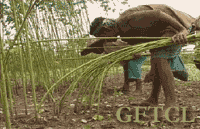Juta (tkanina)
| Ten artykuł od 2022-12 wymaga zweryfikowania podanych informacji. |

Juta − włókno łodygowe produkowane z rośliny z rodzaju juta, uprawianej w Chinach, Pakistanie i innych krajach o gorącym, wilgotnym klimacie. Terminem tym określana jest również wytwarzana z niego tkanina o splocie płóciennym. Występuje w kolorze szarym lub złotawym, włókna juty dobrze i łatwo się barwią, natomiast bielenie ich jest trudne. Występuje w gramaturach od 125 g/m² do 350 g/m². Włókno jutowe, po bawełnianym, jest najbardziej rozpowszechnione (ze względu na swoją taniość i dużą wydajność).
Zastosowanie
- worki
- ogrodnictwo (zabezpieczenie brył korzeniowych, pni podczas transportu)
- dekoracja wnętrz
- maskowanie
- sznury
- odpadki juty znajdują zastosowanie w przemyśle papierniczym
Media użyte na tej stronie
Autor: SoylentGreen, Licencja: CC-BY-SA-3.0
Hessian Fabric made seamless. It will serve to create a normal map in Blender.
Autor: Mahbub Hasan, Licencja: CC BY 2.5
Picture of transformed Jute locally known as Path Khori
(c) Pathikbd z angielskiej Wikipedii, CC BY 2.5
The picture of Bangladeshi farmers harvesting Jute stalk. The stalk is cut from the root with a saw-like spade. The left out root enriches the soil for next cultivation. However, if the field is flooded with rich alluvial silts, then the stalk can be uprooted totally.
After harvesting, the stalk is tied into bundles and submerged in water for retting.
Source
Video brochure of International Jute Study Group (IJSG), a non-profit organization operated jointly by UNCTAD, International Commodity Body (ICB), governments of Jute producing countries. The extraction of movie and creation of image file was created by the author. The image is not available in the sites of IJSG or GFTCL.




